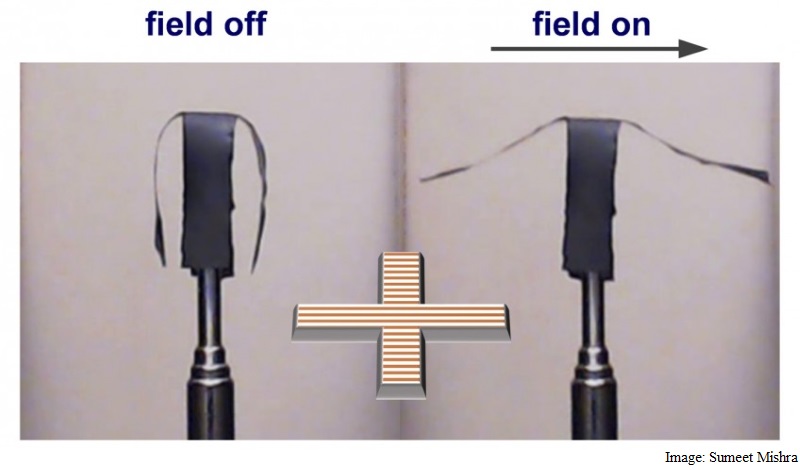- Home
- Science
- Science News
- New Nanoparticle Chains to Control 'Soft Robots' Developed
New Nanoparticle Chains to Control 'Soft Robots' Developed

The ability to control the motion of soft robots, coupled with their flexibility, gives them potential applications ranging from biomedical technologies to manufacturing processes, researchers said.
A team of researchers from North Carolina State University (NC State) found a way of embedding long chains of nanoscale magnetite particles in sheets of elastic polymer to form a magnetic polymer nanocomposite.
By applying a magnetic field, the researchers can control the way the nanocomposite bends - making it a soft robot.
The process begins by dispersing nanoparticles of magnetite, an iron oxide, into a solvent. A polymer is then dissolved into the mixture, which is poured into a mold to form the desired shape.
A magnetic field is then applied, causing the magnetite nanoparticles to arrange themselves into parallel chains.
The solution is dried, locking the chains into place, and the finished nanocomposite can be cut, to further refine its shape.
"Using this technique, we can create large nanocomposites, in many different shapes, which can be manipulated remotely," said lead author Sumeet Mishra, a PhD student at NC State.
"The nanoparticle chains give us an enhanced response, and by controlling the strength and direction of the magnetic field, you can control the extent and direction of the movements of soft robots," Mishra said.
The researchers have also constructed a simple model to explain how the chained nanoparticles affect the mechanical response in magnetic fields.
"The key here is that the nanoparticles in the chains and their magnetic dipoles are arranged head-to-tail, with the positive end of one magnetic nanoparticle lined up with the negative end of the next, all the way down the line," said corresponding author Joe Tracy, from NC State.
"When a magnetic field is applied in any direction, the chain re-orients itself to become as parallel as possible to the magnetic field, limited only by the constraints of gravity and the elasticity of the polymer," he said.
The researchers believe this technique may be especially attractive for some biomedical applications, as compared to soft robotics that rely on electricity or light for control.
"Electrical control can raise safety issues for some medical applications," said Mishra.
"And both electrical and light signals pose challenges in terms of communicating those signals to devices embedded in the body. Magnetic fields, on the other hand, pass through easily - and pose fewer safety challenges," he said.
The study was published in the journal Nanoscale.
For the latest tech news and reviews, follow Gadgets 360 on X, Facebook, WhatsApp, Threads and Google News. For the latest videos on gadgets and tech, subscribe to our YouTube channel. If you want to know everything about top influencers, follow our in-house Who'sThat360 on Instagram and YouTube.
Related Stories
- Galaxy S24 Series
- MWC 2024
- Apple Vision Pro
- Oneplus 12
- iPhone 14
- Apple iPhone 15
- OnePlus Nord CE 3 Lite 5G
- iPhone 13
- Xiaomi 14 Pro
- Oppo Find N3
- Tecno Spark Go (2023)
- Realme V30
- Best Phones Under 25000
- Samsung Galaxy S24 Series
- Cryptocurrency
- iQoo 12
- Samsung Galaxy S24 Ultra
- Giottus
- Samsung Galaxy Z Flip 5
- Apple 'Scary Fast'
- Housefull 5
- GoPro Hero 12 Black Review
- Invincible Season 2
- JioGlass
- HD Ready TV
- Laptop Under 50000
- Smartwatch Under 10000
- Latest Mobile Phones
- Compare Phones
- Huawei Pura 70 Pro+
- Huawei Pura 70 Ultra
- Tecno Camon 30 Premier 5G
- Motorola Edge 50 Fusion
- Oppo A1i
- Oppo A1s
- Motorola Edge 50 Ultra
- Leica Leitz Phone 3
- Asus ZenBook Duo 2024 (UX8406)
- Dell Inspiron 14 Plus
- Realme Pad 2 Wi-Fi
- Redmi Pad Pro
- Cult Shock X
- Fire-Boltt Oracle
- Samsung Samsung Neo QLED 8K Smart TV QN800D
- Samsung Neo QLED 4K Smart TV (QN90D)
- Sony PlayStation 5 Slim Digital Edition
- Sony PlayStation 5 Slim
- IFB 2 Ton 3 Star Inverter Split AC (CI2432C323G1)
- Daikin 1 Ton 3 Star Inverter Split AC (FTKL35UV16W+RKL35UV16W)

















